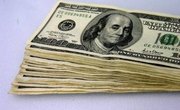As the summer of 2019 drew to a close, world markets were on shaky grounds. A trade war commanded headlines globally as tariffs piled up between China and America, and Sept. 1 brought a new 15% levy against finished consumer goods coming from the Asian juggernaut.
News outlets wrote about what the tariffs would mean to the average American household, while others reported that nations like Japan, recovering from its own economic uncertainty, were growing alarmed over what the tariff-based trade war might mean worldwide. American farmers and small businesses got a crash course in the disadvantages of tariffs.
Tip
Tariffs are taxes put on imports from other countries. Meant to protect domestic industry, the tariff ultimately is paid by the end consumer and means higher prices on the shelves.
How Do Tariffs Work?
The tariff is a trade tax. It can either be a fixed price or a percentage, the latter being tacked onto whatever the importing price is. When a company sends products to another country, they’ll be charged the tariff on top of their selling price, but the seller gets that money back by charging the retailer or distributor the same increase. They, in turn, generally pass that cost on to the consumer when they raise their prices to compensate.
Tariffs can be charged for numerous reasons, but a common perception is that they can help domestic industry weather a challenge from competitors abroad who may have lower overhead, material, labor and/or manufacturing costs. This may be the case sometimes. The problem is that these government tactics are seldom unilateral, and responses are almost always forthcoming. So, the seller’s country takes offense at said tariffs, then often retorts with a tariff of their own.
And, ultimately, tariffs tend to slow economies rather than boost them, because as things become more expensive to purchase, consumer confidence tends to wane. With that, retail sales and construction can falter, because while the smaller items begin nickel-and-diming consumers, big-ticket purchases can be drastically affected by accumulation.
Why Were Low Tariffs Popular?
Protectionism — operating a trading culture that imposes high tariffs on imports and uses strict quotas, all under the guise of protecting domestic industry — is the “charity begins at home” philosophy writ large on international markets. It’s about governments favoring their nation’s domestic trading status, protecting their home industries. But for much of the recent decades, free trade has been the order of the day between nations — low tariffs, favorable quotas. This goes back to 1934, five years into the crippling global depression initiated by the Black Tuesday Stock Market Crash of 1929.
Since 1922, the U.S. had punitively high tariffs anyhow, thanks to the Fordney-McCumber Act levying up to 40% tariffs on some products. The 1930 Smoot-Hawley Act, though, went even further.
Over 1,000 economists signed a petition decrying the act, but it was signed into law and tariffs jumped another 20%, which led to reactive increases worldwide over the next two years. It was a brutal blow to international trade and hamstrung most nations' economies as businesses had to rely solely on their domestic trade for their economies, and it wasn't enough. Smoot-Hawley is recognized today as being the critical factor in the prolonging and worsening of the Great Depression, which caused upheaval around the globe.
Four years later, in 1934, American unemployment hit 21.7% and world trade had plunged an estimated 66% between 1929 and 1934. Drastic measures were needed. Franklin Delano Roosevelt undid Hoover’s gaffe by signing the Reciprocal Tariffs Agreement, which quickly and significantly lowered tariffs (by as much as 50% on some items) and kick-started world trade. Slowly, the job market also began to rebound.
Passing the Buck
The biggest problem with trade wars and tariffs is that prices eventually go up: it's unavoidable. Say a tariff goes against smartphones tomorrow, adding 20% to their price. Now, a $600 phone should, theoretically, go up to $720, but that won’t happen tomorrow, and maybe won’t happen at all. The retailer would have ordered a larger quantity of phones, and they won’t feel the pinch of the higher prices until they restock their supplies.
But when they do restock the phones, will they be able to sell them with the 20% price increase? Probably not, because incomes aren't rising and consumers often can't justify the cost, so instead of raising the price by 20% to completely make their expenses back, they will instead raise the prices by perhaps just 10%. Now, not only is the importer paying more for their supply, they’re selling it for a slight loss, but the consumer is also paying more. In this instance, no one wins except the tariffs department, or maybe a domestic manufacturer — but what if the manufacturer got their parts from a tariff-affected country? Those consequences are same-same but different.
In fact, these kinds of trade wars have even more impact, because the consequence of raised tariffs is they hurt small businesses more than large ones. But when 48% of Americans work for the 30 million small businesses in the nation, anything that hurts mom-and-pop businesses hurts everyone. Large companies weather these wars because they buy more of their products at once, getting favorable rates that absorb the shock of the new tariffs a bit better. Smaller companies are stuck ordering in low quantities and trying to compete with deep-pocketed big box shops.
Peripheral Damage From Price Hikes
When prices go up, a few things then happen. Take the China-America trade war, for example, where one year into the spat, premium men’s dress pants that would have been $125 got hiked up to $149 a pair. With prices rising so considerably in such a short time, retailers eat some loss, consumers eat some of the cost, but a more common consequence is that people just stop spending money when they perceive they’re getting less value for more money.
When consumers stop buying products, shops are either stuck slashing prices or being burdened with expensive inventories. Plus, shops will often try to predict the future as markets rumble with talks of increasing tariffs — prompting purchasing agents to make large purchases before rate hikes get implemented, which can tie up their cash flow. (And go badly if they've miscalculated.)
Slowly but surely, those slowing sales and burdensome stockrooms lead to jobs being lost and unemployment rising. Capital purchases, like cars, can suffer tremendously if their parts or the entire product should rise in cost. Without big-ticket purchases, the economy begins to slow even faster and job markets can be crippled.
The Consumer Economy Downside
Big-ticket items may have the flash and bang of dramatic impacts on the economy, but it’s the day-to-day purchases jumping 10, 15, 20 and even 25% in price in just months that really hurts the average American. The country is one of the most consumer-based economies on earth, being 70% dependent on Americans getting out there and spending their dough on everything from toothpaste to televisions. When that spending dries up, the American economic engine falters.
“Consumer confidence” is a phrase bandied about often in stock market coverage, and it’s really just about whether consumers feel like they can live their lives normally while still paying the mortgage. When everything from rice to bread starts costing more, people really start to wonder about how secure their future is. They buy a cheaper product or stretch its use out for longer, or simply stop buying it altogether, and so the economy starts to contract.
Tariffs as Defensive Plays
The quid pro quo of raising tariffs and causing a trade war hurts domestic companies trying to sell their products abroad. This can go three ways: one, the company mitigates the effects of tariffs on international trade by lowering their prices; two, the company can stop doing international business and focus on the domestic market; and three, the company can relocate some of their operations abroad in order to get around the tariffs that would have been imposed on products coming from the U.S. The latter is a problem because it doesn't just hurt the domestic economy, it costs some regions their high-paying jobs too.
One example was the arduous tax levied against the iconic Harley Davidson for their European Union sales. As American policies grew isolationist during 2018, the EU imposed a retaliatory tariff on everything deemed to be truly American, like motorbikes and bourbon. Harley Davidson said the jump from a tariff of 6 percent on its bikes up to a whopping 31% meant losses of up to $220 million over 2018 and 2019. As a result, they decided they’d increase production in Europe to handle more of those estimated 40,000 sales per year, to offset the burden of $2,200 average in tariffs per bike.
Currency Manipulating: Countering Tariffs
The China-America trade war began in 2018, conveniently coinciding with what became a long slow plunge of the Chinese yuan’s value. A nation devaluing its currency isn’t a contravention unless the IMF and others decide it’s manipulating the currency to create better trading circumstances. The trouble is, that’s very hard to prove, and apart from pointing fingers at China for devaluing the yuan, there was little anyone could do to stop it.
With the yuan considered as much as 6% to 12% undervalued by the IMF, it meant China was better positioned to ride out the trade war than their American counterparts were. By allegedly manipulating their currency, it made Chinese goods cheaper to sell internationally, while raising the cost of imports from America.
Still, it’s not smooth sailing during such times, because the tariffs still rose 25% or so, depending on the products in question. The burden of higher prices was unavoidable, but at least the damage was reduced for the Chinese. Unfortunately, it affects the whole world’s economy, given the vast reach of Chinese investments and how heavy-hitting Chinese exports are on the world stage. A majority of Chinese investments abroad were done under American currency, meaning investors’ loans would cost more yuan to pay off. All this is to say there’s simply no easy way to undo the damage of an excessive trade war, and ultimately everyone pays the price.
The High Cost of Tariffs
When tariffs rise, it sets off a chain reaction. There’s always a knee-jerk response as countries try to protect themselves. In a global age, the effects of tariffs on international trade mean everyone feels the pain when trade agreements become protectionist.
Lower demand for products beyond producers’ domestic markets means taking what could be significant business away. With that, production slows, fewer workers are needed and unemployment soon rises at the same time as prices begin rising.
The trouble began slowly in 2018 but as the tariff battle seemed immovable, slowly the carnage began playing out — bailouts for soy and other farmers, steel plants laying workers off, families cutting back on purchases. Low tariffs may create revenue for countries, but high tariffs can create economic havoc. Finding the right balance is a struggle that causes debate between economists, who agree on one thing — playing nice with other markets and creating conditions that are favorable for trade is the way to grow economies and a global market goes a long way in making that growth happen.
Related Articles
References
- USA Today: Store executives starting to worry about tariffs’ effects on consumers
- New York Times: China’s Currency Moves Escalate Trade War, Rattling Markets
- USA Today: Trade War: How tariffs on clothing, TVs and school supplies could affect you next week
- Forbes: Here's How Much Apple And Others Will Suffer From New Trump Tariffs
- Encyclopedia Britannica: Smoot-Hawley Act
- Woodrow Wilson Center for Scholars: Chapter 1: U.S. Trade Policy in Crisis
- Reuters: Explainer: U.S. branding of China as currency manipulator offers few new remedies
Writer Bio
Steffani Cameron is a nomad, writer, photographer, from Vancouver, Canada, who is slow-travelling the world for five years. Her work has appeared in Washington Post, Vox Media, Kitchn, About, and more.










